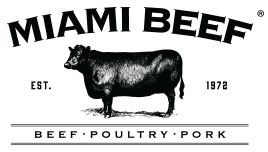Understanding Primal Cuts and American Beef Grading
At Miami Beef, we’ve been a leading supplier of quality meat to the hospitality, food service and retail sector, for more than fifty years. In our time within the meat industry, we’ve observed changing consumer and distributor demand for specific cuts and portions of meat, that reflect the changing needs of business partners, and American consumers.
In the United States, beef is classified into two main categories, forequarter and hindquarter primal cuts. Within each category, are individual cuts of beef that are suited for a variety of end-user purposes, from premium steaks, to simmering selections and ground beef.
Forequarter Primal Cuts
The forequarter of cattle, is the front section of the livestock, which contains more connective tissue, muscle, bone and sinew. Cattle are naturally more muscular in the front areas, where they rely on these structures for movement, and grazing activities.
The meat selections butchered from the forequarter, are less tender than hindquarter primal cuts for this reason. In terms of preparation, these cuts require tenderizing and margination, but they are ideal for use with slow-cooking methods, that break down the consistency of the beef into moist and delicious meal components.
a) Brisket
Smoked brisket is popular across the United States, but in high-demand for southern American grocers and the food service industry. Brisket utilizes meat cut from the breast and lower chest of beef or veal; it includes muscle structures that support approximately 60% of the body weight of standing cattle.
Marinated brisket that is slow roasted at low temperatures (such as smoked meat preparation) is ideal as it breaks down that connective tissue and tenderizes it naturally.
b) Plate
The plate beef (sometimes referred to as short plate) is another popular forequarter cut that is processed for the American market. From the plate selection, butchers carve skirt steaks, which are commonly sold as meat to be used for fajitas. The navel area of this cut is also used for ground beef.
c) Shank
Stewing beef selections are cut from the shank section. The meat in the shank area represent the toughest of all beef cuts, with little to no fat marbling. It requires a long period of boiling and simmering, to become tender, but is ideal for use as a healthy protein in stews or soups. Beef shank is also the source of tender bone-in ‘osso buco’ for consumers, and fine dining establishments.
d) Rib Section
The rib section is the source of affordable ribeye steaks, rib chops, and delicious boneless Prime Rib roasts. This forequarter area of cattle, offers very tender cuts of beef, and are higher priced, for a premium meal experience.
e) Chuck
Chuck Roasts and steaks represent a great combination of flavor, cooking flexibility and value to the American consumer and the food service industry. Trimmings from the production of Chuck Roast are utilized for ground beef, the star ingredient in sauces, homemade hamburgers, chilli and other popular menu items.
Hindquarter Primal Cuts
The hindquarter cuts are the source of the highest quality, premium beef selections. They are butchered from areas of cattle that do not contain excessive bone, muscle or sinew. The hindquarter primal cuts are accessed by fine dining establishments, and by consumers who want the highest quality for grilling at home.
a) Short Loin
This portion of American beef, is about 16 to 18 inches long. The average beef short loin will produce up to 14 steaks, depending on the desired thickness of the cut. Club steaks, t-bone and porterhouse steaks are carved from this area.
b) Tenderloin
They don’t call it tenderloin without good reason. Beef tenderloin is in the loin area of American cattle, and it is made from the tip of the pointed end of the tenderloin, to create the luxury filet mignon cut. Fine dining establishments utilize the center cut to create Chateaubriand, which is typically carved table side for guests, or on a five-star service line as a menu item.
c) Round
There are three subprimals located in the beef round. The top round, or inside round, the bottom (outside round) and the knuckle. The top and bottom round cuts are lean, and do not contain a high level of collagen, which turns into gelatin when roasted. They are a less moist and tender meat, compared to a chuck roast.
The beef round is derived from the back leg of cattle, and meat cuts from this area have little marbling, as it is predominantly muscle.
d) Standard, Top and Bottom Sirloin
These coveted steaks are cut from the rear back portion of cattle, located near the short loin section. The top sirloin is a premium cut and is well marbled and perfect for grilling. Bottom sirloin cuts are less tender, but generally cut into larger portion sizes, making it a consumer pick for family dinners, where the steak can be shared to serve more than one person.
e) Flank
The flank area produces flat flank steak, which is also sometimes referred to as London Broil. Meats derived from this section are considered tougher and require slow grilling and margination to be tender. Flank steak is the primary cut used for fajita meat commercially, and by consumers.
It is important to note that internationally, there are other classifications for beef cuts that vary by country and reflect consumer preferences. Our USDA Headquarters facility, uses state-of-the-art and advanced technology to control temperature, and screen thoroughly with metal and bone fragment detection.
At Miami Beef, we are third-party audited by independent inspectors, as part of our quality control program, to insure food safety and hygiene throughout all stages of meat processing. Our staff undergo GMP (Good Manufacturing Practice) training sessions, and our products are constantly tested through every stage of processing, including certified microbiological pathogen screening, and nutritional analysis.
Make Miami Beef your resource for safe, and consistently high-quality frozen meats. Contact us for more information.

